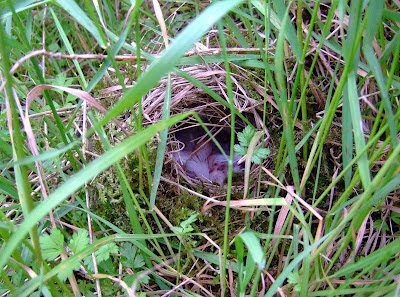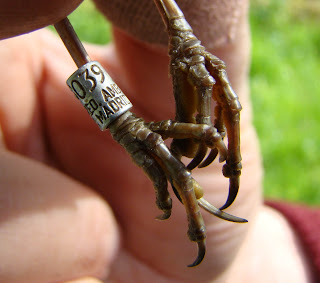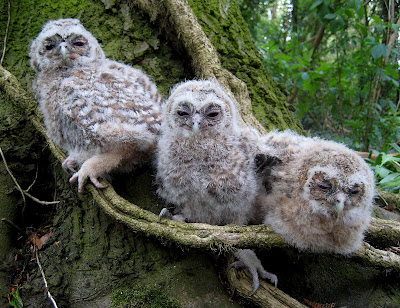Ian and I spent a very pleasant evening checking a handful of boxes in the Vale last night. A roosting Barn Owl in the first, a mum and two chicks in the second, Barn Owl pellets in the third (a box that has only ever had Stock Dove before), Stock Dove on two eggs in the fourth and a bit of a surprise in the last as I reached in and pulled out something a fraction of the size I was expecting. These four Little Owl chicks were in the box in the paddock where we keep our horse and I knew they were around, but assumed they had a perfectly good natural site. The box has only been up 4 years and in that time it's had Barn Owls twice, one blank year and now these!
And on top of that we saw a good selection of other species like Grey Partridge and Yellow Wagtail, my first Azure Damselfly of the year and a purring Turtle Dove which had us both bouncing out of the car just as we were about to leave one site.
Pete
Wednesday 30 May 2012
Attenborough CES visit 3, Sunday 27 May
Gary, Duncan, Steve, Nabegh, Tim and I completed the third CES visit to Attenborough on Sunday. The weather was not good for netting, not a cloud in the sky all morning, hot and a steadily increasing breeze. The water level on site had gone down a little more which made things easier but the mosquitoes have arrived in force and made a menace of themselves - despite Tim switching on the anti-mosquito app he has on his phone. Most birds were caught in the first half of the session before the sun got to high and the temperature increased. The total catch was 31 including 6 retraps made up of (new/others): Wren 3/0, Dunnock 3/1, Robin 1/0, Blackbird 2/0, Song Thrush 1/0, Reed Warbler 2/0, Garden Warbler 2/0, Blackcap 1/0, Chiffchaff 3/4, Great Tit 1/1, Tree Creeper 1/0, Greenfinch 1/0, Bullfinch 3/0, Reed Bunting 1/0. Duncan took Steve and Nabegh off in the quieter moments to check some of the nest boxes and they ringed 18 Great Tit pulli. Unusually low number of Blackcaps caught and only the second ever Greenfinch caught on a CES visit.
Kev
Kev
Sunday 27 May 2012
Box-checking, Sunday 27 May
Managed to check another 15 large boxes today, mostly Kestrel and a couple of Barn Owl. Of these 2 had old Jackdaw nests from which the young appeared to have fledged and one had 4 nestling Jackdaws in. 2 had Stock Dove eggs. Five were occupied by Kestrels at a variety of stages from eggs (a clutch of 4 and a clutch of 5) to tiny young (another 4 and 5) and one had 5 ringable young. So good occupancy and good sized broods.
Pete
Pete
A typical Jackdaw nest, overflowing with twigs. (PML)
Its four occupants. (PML)
Kestrels at various stages. (PML)
Goldfinch recovery
I've never done any ringing in my garden. Since we've lived here I've just not had the time. And despite having a conservatory, we rarely find bird casualties in the garden. Perhaps the local moggies get to them before we do. So when my two year old daughter pointed out a dead Goldfinch in a corner and I picked it up to find it had a ring on, I assumed that my better half was part of an elaborate wind up. But it would seem that this is not the case and against all the odds, I have a intriguing recovery. Anyone claim X683523? I could be wrong, but I don't think it's an SNRG ring...
Pete
Pete
Tuesday 22 May 2012
More Tawny Owl boxes
Despite Kev's fortunes, it hasn't been a disasterous season everywhere and with boxes in areas very close to Kev's I've had quite the opposite experience. I also check just over 20 Tawny Owl boxes and have ringed 7 broods (16 chicks, 3 new adults and a retrap). It doesn't seem fair, but thankfully it shows that results are patchy this year as opposed to down everywhere.
Pete
Pete
Tawny Owl boxes
Having travelled for miles, spent a fortune on petrol, tramped around countless woods bearing ladders my sum total from over 20 boxes checked is 1 chick ringed, 1 clutch of 1 egg still being incubated (don't think this will hatch) and 1 failed at the egg stage. I dare not work out the price of ringing that one chick in either monetary or time costs in case it puts me off for good. All in all a pretty disastrous year for me!
Kev
Kev
Holme Pierrepont, Sunday 20 May
Duncan, Steve, Nabegh, Gary and I made a visit to Holme Pierrepont on Sunday in calm, overcast but cool conditions. As at Attenborough some of the rides that are normally dry were a little wet but still easily workable. We put up 14 nets and had a steady catch throughout the morning ending with 65 birds including 21 retraps made up of (new/retrap): Wren 0/1, Dunnock 1/0, Blackbird 0/1, Sedge Warbler 8/2, Reed Warbler 15/3, Whitethroat 0/1, Garden Warbler 3/0, Blackcap 2/1, Chiffchaff 1/2, Willow Warbler 1/3, Blue Tit 1/2, Great Tit 8/2, Chaffinch 0/2, Reed Bunting 4/1. The catch included a Sedge Warbler and Willow Warbler control and 8 very recently fledged Great Tits, along with their parents. Overhead were good numbers of Swifts and a Peregrine.
Kev
Kev
Linnet nest, 22 May
Pete and I ringed 3 healthy Linnet chicks in glorious sunshine near my house this morning out of an initial clutch of 5.
Ian
Ian
Monday 21 May 2012
Nest finding in Cropwell Butler (and beyond...)
I must admit, I always regarded nest-finding as a bit of a 'dark art' and perhaps this is what actually appealed to me in the first place. However; after mastering some useful field techniques, taking the time to watch the birds from a distance and getting key pointers on their behaviour, it all started to make a bit more sense.
Upon returning home I have spent the past week or so sharpening my new found skills around Cropwell and have been pleased to locate (and ring chicks at) a number of nests; including a rather open Goldfinch nest in a young sapling, a Blackbird nest in my garden and a Linnet nest which I found when tapping along a hedgerow and flushing the female.
Fellow ringer, nest finder and Cropweller Ian Kirton was kind enough to spend some quality time explaining how to study Skylark and Yellowhammer, pointing out key clues that helped us to identify birds visiting the nests with food and leaving with faecal sacks. He then helped to guide me to the spot where the birds were and joined me for a more thorough search.
After talking to the BTO team and Ian, it is becoming clear that 2012 is turning out to be a rather odd year, with weather conditions pushing Whitethroat arrival and breeding back by a good number of weeks. Likewise, birds that have started breeding appear to be at various stages; some Skylarks for example, are brooding large chicks, others incubating eggs and others only just building nests!
Jim and I noticed that perhaps Barn Owls are a bit 'all over the place' with their breeding this year too. Let's hope things warm up a little over the coming weeks and increase food abundance for all of our young birds.
Ian
Goldfinch, 6 May
Willow Warbler, 21 May
Yellowhammer, 20 May
two Skylark nests, 20 May
Thursday 17 May 2012
Recent Recoveries
Three recoveries through - a Carrion Crow ringed as a chick in Hucknall in May 2010 and found dead 4km in Bestwood in February of this year, a Barn Owl ringed as a chick last September in Greasley found dead 8km away in Codnor, Derbyshire in March and a Brack Yellowhammer, ringed in March 2011 and found dead by a window in Morton, 5km away, this March.
Tuesday 15 May 2012
Attenborough, Monday 14 May
Mick and I returned for the final brood of Grey Herons yesterday. Without Tim's patch knowledge it took us four goes to find the right islet and ring the last two accessible chicks. In doing so we found two dead chicks which had been ringed on 23 April. I must say that the latest chicks looked far healthier than the chicks we ringed earlier in what appears to be a poor season for them.
We also checked to see how the tree nesting Cormorants chicks were doing. Answer: much better as we'd found three dead on the 23rd. As you can see in the pictures, the chicks were 'branching' and the nests we'd ringed previously had same size broods now. It felt a bit like the Everglades . . .
Jim
We also checked to see how the tree nesting Cormorants chicks were doing. Answer: much better as we'd found three dead on the 23rd. As you can see in the pictures, the chicks were 'branching' and the nests we'd ringed previously had same size broods now. It felt a bit like the Everglades . . .
Jim
Monday 14 May 2012
Attenborough CES visit 2, Sunday 13 May
Gary, Duncan, Nick, Libby and I were greeted by a fine morning for the second CES session. The water level on site had gone down a little so we quickly erected the nets and hoped for a decent catch. Catching started slowly but then picked up during the middle of the session only to fade away towards the end, however the wind had picked up by then.
The total catch was 32 including 1 retrap and 1 control made up of (new/others): Wren 4/0, Dunnock 2/1, Robin 2/0, Blackbird 1/0, Song Thrush 2/0, Sedge Warbler 0/1, Blackcap 5/0, Chiffchaff 3/0, Long-tailed Tit 2/0, Blue Tit 1/0, Great Tit 5/0, Chaffinch 1/0, Bullfinch 3/0.
Interestingly we did not catch any of the birds handled on the first visit. The best bird of the day was undoubtedly the Sedge Warbler. It is not a species we normally catch on this site, we ringed one in 2011 which was the first since 2006 - but the bird we caught on this session did not need ringing as it was already wearing a Spanish ring.
Kev
The total catch was 32 including 1 retrap and 1 control made up of (new/others): Wren 4/0, Dunnock 2/1, Robin 2/0, Blackbird 1/0, Song Thrush 2/0, Sedge Warbler 0/1, Blackcap 5/0, Chiffchaff 3/0, Long-tailed Tit 2/0, Blue Tit 1/0, Great Tit 5/0, Chaffinch 1/0, Bullfinch 3/0.
Interestingly we did not catch any of the birds handled on the first visit. The best bird of the day was undoubtedly the Sedge Warbler. It is not a species we normally catch on this site, we ringed one in 2011 which was the first since 2006 - but the bird we caught on this session did not need ringing as it was already wearing a Spanish ring.
Kev
Saturday 12 May 2012
Tawnys, Saturday 12 May
Did the final round-up of my Tawny boxes today ringing two broods of three and one of two. Chicks all looking pretty good, though prey remains in boxes were predominantly birds. The exception being another half eaten rat.
Pete
Pete
Radcliffe-on-Trent Golf Club (PL)
Jericho Farm (PL)
Bartons, Stathern (PL)
Friday 11 May 2012
Long-eared Owls
Jim and I recently followed up a lead on some Long-eared Owls near Newark. On arrival the habitat looked distinctly unremarkable and until I saw a nest with my own eyes, I couldn't quite believe it was all genuine. In actual fact, there were two pairs, fairly close together, both in old corvid nests and both in medium height hawthorns in the same rather scruffy hedgerow.
The first nest held a single chick which was easy to reach and mum appeared quickly on the scene having obviously been in a roost spot very close. She treated us to some fantastic views as she watched our brief intrusion (which I failed to do justice to with my pocket camera).
On the second nest a female sat tight, revealing herself with her long ears...
Whilst wandering about in the area, we also noted a singing Gropper, a Hobby, 2 Wheatears, the odd Sand Martin and Yellow Wagtail and as the light faded a Roe buck almost walked into us.
Pete
Monday 7 May 2012
Attenborough CES visit 1, Sunday 6 May
Duncan, Nick, Mick P, Gary and I completed the first CES visit of the year in perfect weather conditions. Unfortunately the last few weeks of poor weather meant we arrived on site to find 8 of the 10 net rides under water and only two of us had wellies on! Duncan made a dash back to his car to change his footwear and give us an extra hand with the 'wet' nets. We caught a new Cetti's whilst erecting the long line of nets and later had a Woodpigeon and Sparrowhawk bounce from that line. All in all a good start.
The total catch was 40, including 5 retraps, made up of (new/retrap): Woodpigeon 1/0, Wren 2/0, Dunnock 2/0, Robin 2/0, Blackbird 2/0, Song Thrush 1/0, Cetti's Warbler 1/0, Garden Warbler 1/1, Blackcap 4/0, Chiffchaff 3/1, Goldcrest 2/0, Long-tailed Tit 2/1, Willow Tit 1/0, Blue Tit 1/0, Great Tit 3/1, Treecreeper 1/0, Bullfinch 6/1. The Garden Warbler retrap was a bird ringed on the CES in 2008 and surprisingly not caught again until yesterday.
Kev
The total catch was 40, including 5 retraps, made up of (new/retrap): Woodpigeon 1/0, Wren 2/0, Dunnock 2/0, Robin 2/0, Blackbird 2/0, Song Thrush 1/0, Cetti's Warbler 1/0, Garden Warbler 1/1, Blackcap 4/0, Chiffchaff 3/1, Goldcrest 2/0, Long-tailed Tit 2/1, Willow Tit 1/0, Blue Tit 1/0, Great Tit 3/1, Treecreeper 1/0, Bullfinch 6/1. The Garden Warbler retrap was a bird ringed on the CES in 2008 and surprisingly not caught again until yesterday.
Kev
Cetti's Warbler (GHG)
Garden Warbler (GHG)
Friday 4 May 2012
Attenborough, Monday 30 April
We made the third of our tryout visits to Attenborough on Monday (Kev, Mick, Duncan & moi). Without Tim's local knowledge I think we maybe missed one of the remaining Grey Heron nests, but there's still one that Mick will go back to in a couple of weeks. That's 11 Herons ringed so far. I know it doesn't sound a lot, but put in the context of the effort to get permissions, organise a team and that only c300 Heron chicks are ringed per annum; it was pretty good effort. However, they do not look to be having a great breeding season with only broods of 1s and 2s being ringed.
This autumn we hope to number the heron nests and ensure they are more accessible. Being able to get round the nests more quickly and making an earlier start in the breeding season, should enable us to get a good few more Heron chicks ringed in 2013. As it's a BTO priority, we'll also be looking to colour ring them under the same scheme as the Besthorpe one.
We also ringed another 12 Cormorant chicks, and that's 18 in total. Again pleased with this as none of us had ringed tree-nesting Cormorants before, but we caught them just right in terms of their growth. Advice on ringing these from the BTO was really useful, and I'm enquiring whether we should also colour ring these as part of another project in the UK.
Finally, a big thanks to Graham Bowden for getting us around in the boat and to Mick for the climbing.
Jim
This autumn we hope to number the heron nests and ensure they are more accessible. Being able to get round the nests more quickly and making an earlier start in the breeding season, should enable us to get a good few more Heron chicks ringed in 2013. As it's a BTO priority, we'll also be looking to colour ring them under the same scheme as the Besthorpe one.
We also ringed another 12 Cormorant chicks, and that's 18 in total. Again pleased with this as none of us had ringed tree-nesting Cormorants before, but we caught them just right in terms of their growth. Advice on ringing these from the BTO was really useful, and I'm enquiring whether we should also colour ring these as part of another project in the UK.
Finally, a big thanks to Graham Bowden for getting us around in the boat and to Mick for the climbing.
Jim
(All pics DH)
Subscribe to:
Posts (Atom)


































